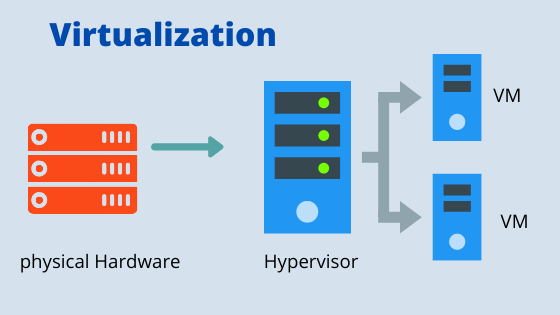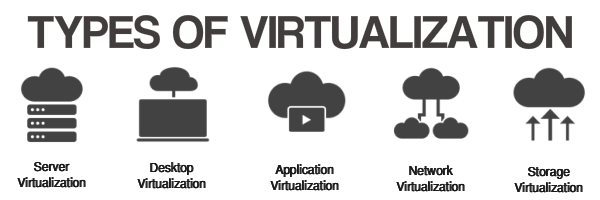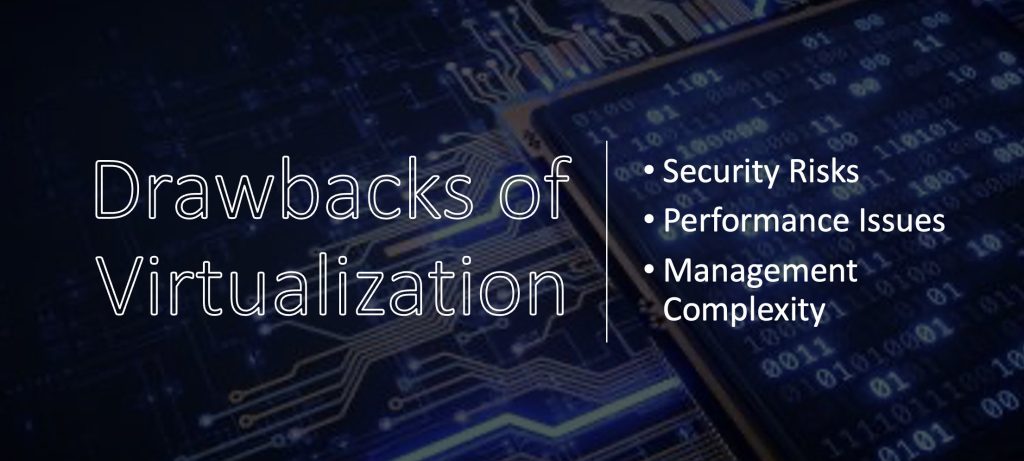What Is Virtualization? Definition, Benefits & Examples
Have you ever felt like there’s untapped potential in your computer hardware that’s just lying dormant? You’re not alone: High-tech costs and underutilized tech resources are common issues for many business owners.
The solution? Virtualization, a powerful tool that lets you get more out of your computer hardware. Imagine having access to several computers at your fingertips—all while using your existing hardware.
While virtualization is commonly used by larger enterprises, small- to medium-sized businesses can also benefit. In this article, we’ll demystify virtualization, and show you how it can transform the way your business operates.
Table of Contents
What Is Virtualization?

Virtualization is a technology that allows you to create and run multiple simulated environments or virtual machines (VMs) on a single physical computer or server. Each virtual machine functions like an independent computer, with its own operating system (OS), applications, and resources, all running on the same underlying hardware.
This concept essentially “splits” a physical machine into several isolated environments, optimizing hardware usage, improving scalability, and simplifying management.
Here are the key aspects of virtualization:
- Virtual Machines (VMs): Virtual machines are software-based emulations of physical computers. They run an OS and applications just like a physical computer but are isolated from one another on the same host machine.
- Hypervisor (or Virtual Machine Monitor): The hypervisor is the software layer responsible for creating and managing virtual machines. There are two main types of hypervisors:
- Type 1 (Bare-metal): Runs directly on the physical hardware (e.g., VMware vSphere, Microsoft Hyper-V).
- Type 2 (Hosted): Runs as an application on top of an existing operating system (e.g., Oracle VirtualBox, VMware Workstation).
- Resource Allocation: Virtualization enables sharing of resources such as CPU, memory, storage, and network bandwidth between VMs, allowing more efficient use of physical hardware.
- Isolation and Security: Each virtual machine operates independently, so if one VM crashes or is compromised, it does not affect other VMs or the host system.
How Does Virtualization Work?
Virtualization transforms one physical computer into several virtual ones. How? The secret lies in a special kind of software called a hypervisor.
Think of hypervisors as the magicians of the virtualization world:
- Type 1 hypervisors. A Type 1 hypervisor runs directly on a computer’s hardware, functioning as its own operating system. They’re commonly used in enterprise environments.
- Type 2 hypervisors. A Type 2 hypervisor is installed on a computer’s operating system, just like any other software. They’re usually seen in individual computing environments.
A hypervisor can create any number of virtual machines on a computer or within a server environment. Each virtual machine works like a separate computer, running its own applications on its own operating system while sharing the resources of the physical computer with other virtual machines running on that same computer.
Types of Virtualization

- Server Virtualization: This involves running multiple virtual servers on a single physical server. It’s widely used in data centers for improved resource utilization and simplified management.
- Desktop Virtualization: Allows the creation of virtual desktops for users. It enables users to access their desktop environment remotely, often used in remote work or thin-client computing setups.
- Storage Virtualization: Combines physical storage from multiple devices into a single virtualized storage pool, which is easier to manage and can improve performance and scalability.
- Network Virtualization: Divides the physical network into multiple virtual networks, which can be configured and managed independently.
What Are the Benefits of Virtualization?

Virtualization offers numerous benefits that significantly improve the efficiency, flexibility, scalability, and cost-effectiveness of IT systems. Here are the key advantages of virtualization:
1. Improved Resource Utilization
- Better Use of Physical Resources: Virtualization enables multiple virtual machines (VMs) to run on a single physical server, maximizing the utilization of CPU, memory, storage, and network resources. This reduces the amount of unused or underutilized hardware, which is common in traditional physical server setups.
- Resource Efficiency: By consolidating workloads onto fewer physical machines, you can use your hardware more efficiently, avoiding the need for excessive hardware purchases.
2. Cost Savings
- Reduced Hardware Costs: Virtualization allows you to run many virtual machines on a single physical server, which means fewer physical servers are needed. This reduces both capital and operational expenditures on hardware.
- Lower Energy Costs: Fewer physical servers lead to less power consumption, which also results in lower cooling costs. This can add up to substantial savings, especially in large data centers.
- Reduced Space Requirements: With fewer physical machines, the physical footprint of your data center shrinks, reducing the need for rack space, physical storage, and associated costs.
3. Simplified Management and Maintenance
- Centralized Management: Virtualized environments are easier to manage through centralized platforms (such as VMware vSphere, Microsoft Hyper-V, or other management tools). You can monitor, configure, and manage multiple VMs from a single interface.
- Easier Upgrades & Maintenance: Since virtual machines are abstracted from the physical hardware, they can be easily moved or migrated to different physical hosts with minimal downtime. This makes system upgrades, patching, and maintenance operations easier and less disruptive.
- Faster Provisioning: Creating and deploying new virtual machines can be done in minutes, compared to the hours or days required to provision a new physical server.
4. Improved Disaster Recovery and Backup
- VM Snapshots and Cloning: Virtualization makes it easy to take snapshots of virtual machines at different points in time, which can be used for backup or disaster recovery purposes. You can also clone VMs for testing or rapid deployment.
- Faster Recovery: If a physical machine fails, virtual machines can be quickly migrated to other hosts, minimizing downtime. Backing up VMs is also faster and simpler than traditional physical server backups.
- Replication & Fault Tolerance: Virtualized environments support features like live migration and replication. In case of a failure, VMs can be automatically moved to a healthy host, ensuring continuous availability and high uptime.
5. Enhanced Flexibility and Scalability
- Easy Scaling: With virtualization, it’s easy to scale your infrastructure. You can create new VMs as needed, and allocate resources (CPU, RAM, storage) to individual VMs dynamically without physical hardware changes. You can scale your infrastructure horizontally (by adding more VMs) or vertically (by increasing resources for specific VMs).
- Dynamic Resource Allocation: Virtualization allows dynamic allocation of resources like CPU, RAM, and storage based on workload demand, making it easy to optimize resource usage and handle peak workloads.
6. Isolation and Security
- VM Isolation: Each virtual machine is isolated from the others, meaning that if one VM crashes or experiences security issues (like a virus or malware), it does not affect other VMs or the host machine. This provides a higher level of security and stability.
- Sandboxing: Virtualization allows you to run potentially risky software or configurations in isolated environments (sandboxes), which can be useful for testing or handling untrusted applications.
- Quarantine and Containment: If a VM is compromised, it can be quickly isolated and deactivated without impacting the rest of the environment, making it easier to contain and recover from security incidents.
7. Increased Availability
- High Availability (HA): Virtualization platforms often include built-in high availability features, which can automatically restart VMs on different physical servers in the event of a failure. This ensures that critical applications remain available and operational.
- Load Balancing: Virtualized systems can be dynamically balanced across multiple hosts, ensuring that resources are efficiently distributed, reducing the risk of overloading any one host.
8. Simplified Testing and Development
- Snapshot and Rollback: Developers and testers can use virtualization to quickly spin up multiple environments for different configurations and operating systems. If something goes wrong, they can easily roll back to a previous snapshot or clone.
- Cross-Platform Testing: Virtualization allows developers to run multiple operating systems on a single machine (e.g., running Windows and Linux on the same system), which is useful for testing cross-platform applications or for running legacy software on newer hardware.
9. Support for Legacy Applications
- Running Legacy Software: Virtualization can help run older applications on modern hardware. For instance, legacy operating systems or software that may not be supported on new physical hardware can be run in a virtual machine, preserving business continuity without needing to maintain outdated physical machines.
10. Improved Mobility and Remote Work
- Desktop Virtualization (VDI): Virtualization enables the delivery of virtual desktops to end users, allowing them to access their desktop environments remotely from any device. This is particularly valuable in remote work, BYOD (Bring Your Own Device) policies, or when providing access to computing resources from different locations.
- Consistency Across Devices: End users can have a consistent experience regardless of the device they use to access the virtual desktop, whether it’s a laptop, smartphone, or tablet.
11. Environment Consolidation
- Server Consolidation: Virtualization reduces the need for a large number of physical servers by consolidating many workloads into a smaller number of physical machines. This can lead to reduced hardware sprawl and more efficient use of space and resources in the data center.
- Cloud Readiness: Virtualized environments are the foundation of cloud computing. They make it easier to migrate workloads to private or public cloud environments, facilitating hybrid cloud architectures.
Risks and Drawbacks of Virtualization

1. Single Point of Failure
- Risk: Virtualization can introduce a single point of failure. Since multiple virtual machines (VMs) run on a single physical server, if the host system experiences a failure (hardware failure, hypervisor crash, etc.), all the VMs on that host can go down simultaneously, potentially affecting multiple applications or services.
- Mitigation: High availability (HA) configurations, clustering, and distributed resource management (DRS) can help mitigate this risk, but they may come with additional complexity and costs.
2. Performance Overhead
- Risk: Virtualization introduces a layer between the physical hardware and the virtual machine, known as the hypervisor. This extra layer can cause some performance overhead, meaning that virtualized workloads may not perform as efficiently as they would on dedicated physical hardware.
- Resource Contention: If several VMs are running on the same host and competing for the same physical resources (CPU, memory, disk I/O), the performance of each VM could degrade.
- Memory and CPU Overcommitment: Some hypervisors allow overcommitment of resources (allocating more virtual RAM or CPU to VMs than physically available). This can lead to resource contention and performance bottlenecks if not managed properly.
- Mitigation: Careful capacity planning, resource allocation, and performance monitoring can help ensure that virtualized environments perform efficiently.
3. Complexity in Management and Configuration
- Risk: While virtualization can simplify management in many cases, it can also increase complexity when dealing with large-scale environments. Virtualized infrastructures often involve managing multiple layers (hypervisors, virtual machines, storage, network resources, etc.), and without the right tools or expertise, this can become difficult to maintain.
- VM sprawl: Without proper management, organizations can end up with an unintentional increase in the number of virtual machines (a phenomenon known as “VM sprawl”), which can lead to inefficiencies and security risks.
- Licensing Issues: Virtualized environments often require careful attention to licensing, as different virtual machines may require separate licenses for both the OS and the applications.
- Mitigation: Using centralized management tools and implementing best practices for monitoring, resource allocation, and patch management can help reduce the complexity.
4. Security Concerns
- Risk: Virtualization can create new security vulnerabilities due to the increased attack surface.
- Hypervisor vulnerabilities: The hypervisor itself is a critical piece of infrastructure. If compromised, it can potentially give an attacker control over all virtual machines running on that host.
- VM Escape: A situation where a compromised VM can break out of its isolated environment and gain access to the underlying host or other VMs. While rare, this is a significant security risk if it happens.
- Resource sharing risks: Since VMs share the underlying physical hardware, improper configuration or lack of isolation could lead to data leakage or access issues between VMs.
- Mitigation: Implementing strong security practices, such as using trusted hypervisors, patching vulnerabilities, applying security updates, employing network segmentation, and regularly auditing configurations, can reduce the risk. It’s also critical to isolate sensitive workloads and ensure adequate resource allocation policies are in place.
5. Hardware Dependence
- Risk: Despite virtualization abstracting away the physical hardware, there can still be dependency on specific hardware. For example, certain features of a hypervisor (like hardware-assisted virtualization, or nested virtualization) may only be available with specific hardware configurations or server models.
- Mitigation: Regularly assess hardware compatibility with the chosen virtualization platform and ensure that your hardware supports the virtualization features you need.
6. Licensing and Compliance Issues
- Risk: Virtualization can complicate software licensing and compliance. Some software vendors charge per virtual machine, while others might charge based on the number of processors or cores. It can become tricky to track and ensure compliance with licensing terms when running virtualized environments.
- Mitigation: Regular audits of virtualized environments and clear documentation of licensing agreements are essential. Using software asset management (SAM) tools can also help ensure compliance.
7. Increased Attack Surface
- Risk: Virtualization increases the number of virtual machines and services running on your network, which can increase the overall attack surface. If not properly isolated and secured, each VM can become an entry point for attackers.
- Increased complexity of network security: Virtual networks and virtualized firewalls can complicate network security configurations. Misconfigurations can lead to network vulnerabilities or unintended access.
- Mitigation: Implementing strict access controls, network segmentation, and firewall policies for each VM can help minimize risks.
8. Dependency on Virtualization Tools and Software
- Risk: Virtualization environments are heavily dependent on specific tools, management software, and hypervisors. If the virtualization platform or management software experiences a bug, vulnerability, or failure, it could affect multiple systems, making troubleshooting more difficult.
- Mitigation: Using well-established and supported virtualization platforms with regular updates, and having contingency plans for critical management tools, can reduce this risk.
9. Storage I/O Bottlenecks
- Risk: Virtualized environments often require high-performance storage systems to handle the additional I/O demands of multiple VMs running on the same host. If the storage system isn’t robust enough, it can create bottlenecks, slowing down VM performance.
- Shared storage issues: Virtualized environments often rely on shared storage for VMs. Overloading shared storage or misconfiguring storage networks can lead to degraded performance, especially in high-demand scenarios.
- Mitigation: Using high-performance storage systems (e.g., SSDs), and employing storage virtualization or network-attached storage (NAS) technologies, can help improve storage performance.
10. Over-Provisioning and Resource Waste
- Risk: Virtualization makes it easy to create and allocate resources to multiple virtual machines. However, over-provisioning can lead to wasted resources (e.g., assigning excessive CPU, memory, or storage to a VM that doesn’t need it), which reduces the overall efficiency of the environment.
- Mitigation: Implementing resource management policies, monitoring system performance, and using tools to right-size VMs can help avoid over-provisioning and improve overall resource utilization.
11. Vendor Lock-In
- Risk: Different hypervisor technologies (e.g., VMware, Microsoft Hyper-V, KVM) often use proprietary formats for virtual machines and management tools. This can lead to vendor lock-in, making it difficult to migrate workloads between different virtualization platforms or cloud environments.
- Mitigation: To avoid lock-in, organizations can use open-source hypervisors (e.g., KVM) or adopt hybrid cloud architectures that allow greater flexibility in moving workloads between different platforms.
